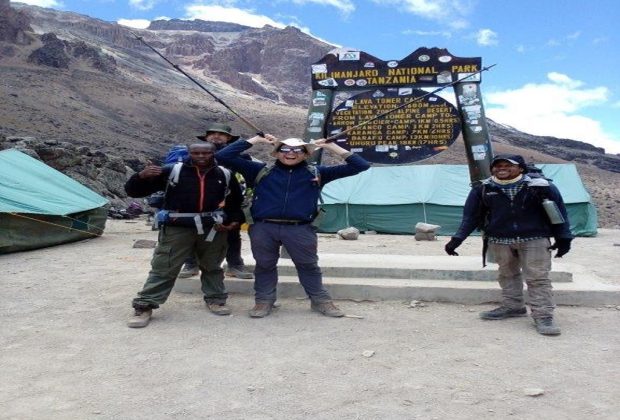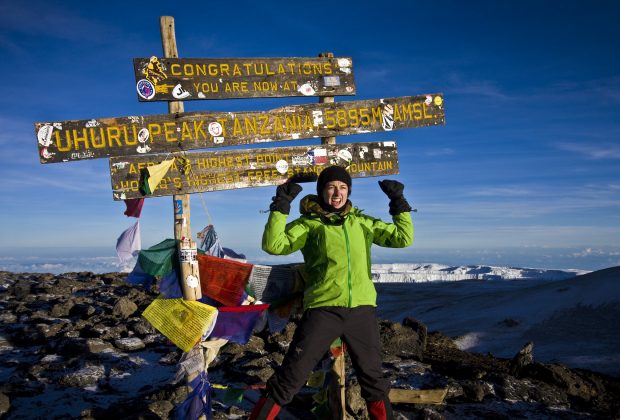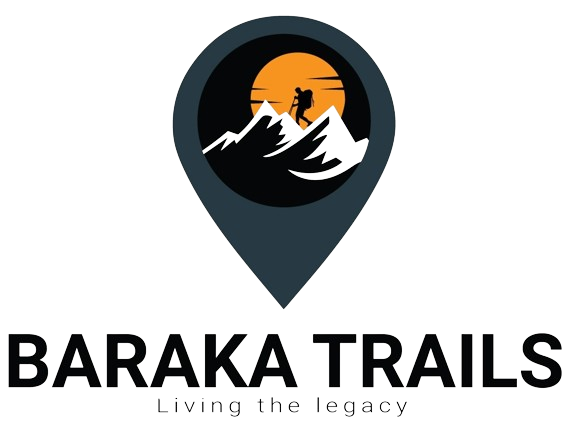


As the only route that approaches Mt Kilimanjaro from the north, the Rongai route has a more gradual slope than the other routes up the mountain. The route approaches Mt Kilimanjaro from the north, beginning with a short drive from the Marangu gate to the Rongai gate. From there, a hike up to Simba camp, a walk through the bush, plantations and rainforest. The Rongai route traverses through moorland over several ridges to Kikeleva caves, then screes to Mawenzi Tarn Camp. An easy angled scree slope then leads across to the Kibo hut. Head to the summit on a steep scree up to Gillman’s point, then continue around the rim to Uhuru peak, the highest point in Africa. The descent is made through the Marangu route
This once in a lifetime experience reward daring few explorers with an unforgettable adventure as they venture the path to the highest point of Africa. Here’s what to expect on this route:
DAY 1: Rongai Start Point (1996m) – Simba camp (2626m)
After an early breakfast from your hotel, you will drive to the Rongai (Nalemoru) Gate near the Kenya border. We begin our climb on this unspoiled wilderness route. The walk then starts to climb consistently, but gently through attractive forest that shelters a variety of wildlife. The forest begins to thin out and the first camp is at the edge of the moorland zone (2600 m.) with extensive views over the Kenyan plains.
The first day is only a half-day walk.
Day 2: Simba camp (2626m) TO SECOND CAVE (3,480m)
The morning walk is a steady ascent up to the Second Cave, (3,450m) with superb views of Kibo and the Eastern ice fields on the crater rim. After hot lunch, we have free time to rest at the camp, or in the afternoon we can explore the surrounding area for an acclimatization walk.
Walking hours: 3-4 hours walking
Day 3: SECOND CAVE (3,480 m) to Kikilewa Camp (3630M)
The morning hike is a steady ascent up to the Second Cave Camp located in the moorland zone with superb views of Kibo and the Eastern ice fields on the crater rim. After lunch at cave camp we carry on with a steady ascent walking though moorland. There are superb views of the Eastern ice fields on the crater rim of Kibo, the highest of the three volcanoes which form the mountain. We will leave the main trail and strike out across moorland on a smaller path towards the jagged peaks of Mawenzi, the second of Kilimanjaro’s volcanoes. We will set up camp today in the sheltered valley near Kikelewa caves at 3630m
Hiking distance: 10 km
Hiking time: 5-6 hours
Day 4: Kikelewa Camp (3630m) to Mawenzi Tarn Hut (4330m)
A Short but steep ascent to Mawenzi Tarn (4330m). Leave the vegetation behind shortly before reaching the next camp at Mawenzi Tarn. The afternoon is free to help your acclimatization.
Kikelelwa Cave to Mawenzi Tarn (4,330m):
Walking: 3-4 hours.
Day 5: Mawenzi Tarn Hut (4330m) ACCLIMATIZATION DAY
Acclimatization day at the camp
Day 6: Mawenzi Tarn Hut (4310m) to Kibo Hut (4700m)
We leave our campsite and cross the lunar desert of the ‘saddle’ between Mawenzi and Kibo After a couple hours trekking, reach this spectacular place, with the summit of Kilimanjaro in the background and our trail to the high camp stretched out before our eyes. Upon reaching our camp the remainder of the day will be spent resting in preparation of the final ascent after a very early night!
Distance covered: 8km / 5mi
Approx. time taken: 5 – 6 hours
DAY 7: Kibo Hut (4700m) to UHURU PEAK (5895m) TO HOROMBO HUT (3100M)
SUMMIT DAY 5,895MT
Wake up before midnight in the cover of darkness. We begin a steep climb over loose volcanic scree has some well-graded zig-zags and a slow but steady pace will take us to the rim of the main crater, Gillman’s 5,685 m. We will rest there for a few minutes to enjoy the sunrise over Mawenzi. Those who are still feeling good can continue slowly to make the three hour round trip from here along the crater rim to Uhuru peak 5,895 m. which is the highest point in Africa. After a few minutes to appreciate your accomplishment we descend to Kiko Hut is amazingly fast, and we stop at Kibo Hut for some refreshment, we continue to descend to reach Horrombo Hut.
Kibo Hut to Summit to Horombo Hut (3100 m): 13-15 hours walking.
Day 8: Horombo Hut (3700m) to Marangu Gate (1860m)
The last stage passes through the heath and moor zone to the Mandara Hut (2700m) where a warm lunch is waiting for you. Soon, you will once again pass the tropical rainforest and after a total time of 6 hours trekking, you will be back at the Kilimanjaro National Park Gate (1860m). After saying goodbye to your mountain guides, a short transfer follows to take you back to your hotel in Moshi/ Arusha. Once there, you can take a warm and relaxing shower and celebrate your success in reaching the summit of the Kilimanjaro.
Distance covered: 20.8km / 12.9mi
Approx. time taken: 8 hours
Meals: Breakfast, Lunch
- Price Include:
- Private pick up and drop off at Kilimanjaro international airport.
- Accommodation in Moshi/ Arusha, 1 nights before and 1 after the trek (Hotel is Bed & Breakfast basis)
- Park fees, camping fees & rescue fees $20/climber
- 18% VAT on tour fees & services
- 4 Season big sleeping mountain tents
- Double layered Sleeping Mats
- Forest fee $10/person
- Transportation to & from the mountain gate
- Professional mountain guides, cooks and porters
- 3 meals daily while on the mountain
- Filtered water throughout the trek
- Fair wages for the mountain crew as approved by the Kilimanjaro National Park Authority (KINAPA), Kilimanjaro Association of Tour Operators (KIATO)
- Private Portable toilets and toilets tents (option).
- Hot Water For Wash everyday at any time at the cam
Price Exclude:
- International and local flights
- Items of a personal nature (gears can be rented in Arusha)
- Laundry Services (Optional)
- Tips to mountain crew for 8 days trip.
What is Mount Kilimanjaro?
- Mount Kilimanjaro is the highest peak in Africa, located in Tanzania. It is a dormant volcano and one of the most iconic mountains in the world.
How tall is Mount Kilimanjaro?
- The summit of Mount Kilimanjaro, called Uhuru Peak, stands at an elevation of 5,895 meters (19,341 feet) above sea level.
How long does it take to climb Mount Kilimanjaro?
- The duration of a Kilimanjaro climb varies depending on the route chosen. Most climbs typically range from 5 to 9 days.
What are the different routes up Mount Kilimanjaro?
- There are several routes to the summit of Kilimanjaro, each with its own characteristics and scenery. Popular routes include the Marangu, Machame, Lemosho, Rongai, and Northern Circuit routes.
Is climbing Mount Kilimanjaro difficult?
- Climbing Kilimanjaro is challenging due to its high altitude, but it doesn’t require technical climbing skills. However, climbers should be physically fit and prepared for the rigors of high-altitude trekking.
Do I need a guide to climb Mount Kilimanjaro?
- Yes, it is mandatory to have a registered guide accompany you on your Kilimanjaro climb. Guides are essential for safety, navigation, and providing support throughout the trek.
When is the best time to climb Mount Kilimanjaro?
- The best times for climbing Kilimanjaro are during the dry seasons, which are typically from late June to October and from December to March. These months offer clearer skies and better trekking conditions.
What should I pack for climbing Mount Kilimanjaro?
- Essential items for climbing Kilimanjaro include proper clothing for varying temperatures, sturdy hiking boots, a good quality sleeping bag, trekking poles, personal medications, and other necessary gear as recommended by your tour operator.
What are the risks of climbing Mount Kilimanjaro?
- The main risks of climbing Kilimanjaro include altitude sickness, which can affect anyone regardless of fitness level, as well as other potential hazards such as extreme weather conditions and physical exhaustion.
Do I need to train before climbing Mount Kilimanjaro?
- Yes, it is highly recommended to undergo physical training and preparation before attempting to climb Kilimanjaro. This can include cardiovascular exercises, strength training, and hiking to build endurance and fitness levels.
Per Person $2,980
GROUP $2,480

